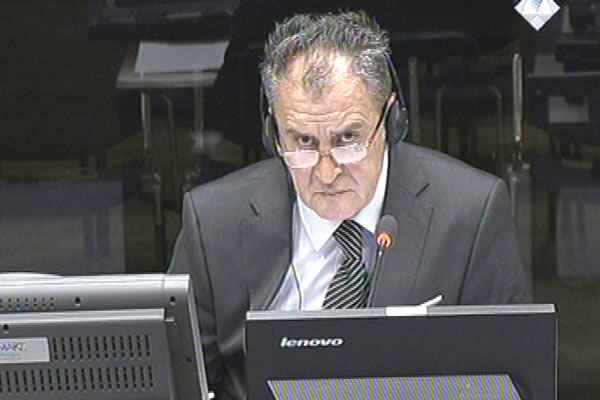Home
‘TYPICAL CIVIL WAR’ IN BH
Mladic’s defense military expert Mitar Kovac concluded that the war in BH was a ‘typical civil war’. Sarajevo was ‘defended’ city ‘blocked on both sides’, Kovac noted. According to Kovac, in Srebrenica Mladic didn’t pursue a ‘murderous’ plan but a ‘humanitarian’ agenda. Late general Gvero commanded the Srebrenica operation ‘on behalf of the Main Staff’ in Mladic’s absence, Kovac explained. Mitar Kovac was awarded the Transfer of Wisdom award at a book fair in Serbia
 Mitar Kovac, defence witness at Rako Mladic trial
Mitar Kovac, defence witness at Rako Mladic trial The conflict in Bosnia and Herzegovina was not international and it was not caused by an aggression launched by Serbia and Yugoslavia. On the contrary, it was a ‘typical civil war’, retired Serbian military general Mitar Kovac explained. Kovac testified as a military expert at the request of Ratko Mladic’s defense. One of the features of that kind of war are ‘sufferings of civilians’, Kovac explained, and the transfer of the ethnic communities to the territories controlled by the troops of the same ethnicity. According to the defense expert, the only outside military force present in BH was the Croatian Army; there were no military units from Serbia in BH.
The tree national armies, which were of the ‘territorial type’ fought each other; the war had strong religious overtones, Kovac said. The Muslims were the first to set up their army in May 1991 when the Patriot League was formed. It was based on Alija Izetbegovic’s views on a unitary Islamic state. The Green Berets was a special unit, part of the Patriot League. These military formations later became the BH Army. A few months later, the Bosnian Croat Army – Croatian Defense Council – was established, with Croatia's support. Only then, when it became clear that BH would not remain in the rump Yugoslavia, the Bosnian Serbs headed by General Mladic formed their army on 12 May 1992, the expert witness recounted.
The prosecution has alleged that the Republika Srpska Army was a highly centralized Soviet-style military system. Kovac begged to differ, arguing that it had elements of both the centralized and decentralized military organization. In a bid to exonerate General Mladic for the actions carried out by units subordinated to him, Kovac stressed that the combined system of command allowed lower-ranking operative units and commands a great deal of ‘flexibility and creativity’.
Presenting the findings from his expert report on Sarajevo, Kovac said that Sarajevo was a city ‘divided, defended and blocked on both sides’. According to Kovac, attacks on Sarajevo using ‘legitimate means of warfare’ including artillery were fully justified. According to Kovac, the disposition of troops reflected the demographic picture of the city. Central municipalities with a prevalent Muslim population were held by the BH Army. The suburban municipalities with a Serb majority were controlled by Mladic’s army. There were about 40,000 or 50,000 soldiers deployed in the city, Kovac estimated. The General Staff and many BH Army unit commands were also located in the city. They were legitimate military targets, Kovac noted. Mladic is not indicted for placing Sarajevo under siege or for attacks on military targets, but for terrorizing the civilian population of the city. As for specific incidents, the witness mentioned only one of them, the first Markale attack on 5 February 1994. According to Kovac, a single 120-mm shell could not have caused such an explosion with so many victims. The prosecution alleges that 66 were killed and 140 wounded in the incident. In Kovac’s opinion, a ‘reinforced explosive device’ was used.
According the witness, the attack on Srebrenica in July 1995 was legitimate because the enclave had never truly been demilitarized. In Kovac’s view, Mladic was not responsible for the events in the field because he was not the ‘operative commander’. It was up to the Drina Corps to plan and implement actions, Kovac said, either on the basis of Karadzic’s Directive 7 or Mladic’s Directive 7.1. There was nothing controversial about the video footage of Mladic arriving in Srebrenica at the head of his forces. It was part of Mladic’s ‘public image’ to always be in the thick of things. Mladic’s ‘physical presence doesn’t mean that he commanded the operation’.
Kovac was particularly keen to exonerate Mladic for the period from 14 to 17 July 1995, when the mass executions were carried out. As Mladic was in Belgrade throughout that time, Kovac argued, the army was under the command of the ‘highest-ranking officer’ in the Main Staff, Milan Gvero. Gvero was convicted of the crimes in Srebrenica and died after serving his five-year sentence. Kovac thus blamed the deceased individuals convicted by the Tribunal for the crimes.
In their evidence the prosecution experts described Mladic’s behavior at the third and final meeting with the Muslim representatives from Srebrenica in the Fontana Hotel in Bratunac on 12 July 1995 as proof of his ‘murderous plan’. The defense expert explained that it was all about a ‘humanitarian goal’ to protect the soldiers of the 28th Division of the BH Army. The accused said at the meeting that the Srebrenica Muslims had to surrender their weapons; they faced the choice of ‘either survival or disappearance’.
The defense’s military expert examination-in-chief was completed today. It remains to be seen if the prosecutor will examine Kovac tomorrow or on Thursday, after two witnesses complete their evidence via video link from Banja Luka.
Linked Reports
- Case : Mladic
- 2015-11-12 OBSTRUCTING ‘NON-EXISTENT’ TRIBUNAL IN THE HAGUE
- 2015-11-11 KRAJINA WAS MLADIC’S TESTING GROUND FOR BOSNIA
- 2015-11-10 ‘THE LESS I KNOW, THE BETTER I AM’
- 2015-11-17 EXPLOITING ISLAMOPHOBIA IN TRIBUNAL’S COURTROOM
- 2015-11-18 ‘PLAGIARISM’ IN MLADIC’S EXPERT REPORT
- 2015-11-19 SARAJEVO CIVILIANS LACKED ‘SAFETY CULTURE’
